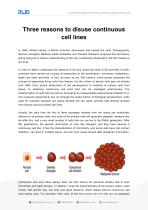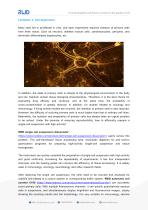 Website:
RWD Life Science
Website:
RWD Life Science
Catalog excerpts

Three reasons to disuse continuous cell lines In 1665, Robert Hooke, a British scientist, discovered and named the cells. Subsequently, German biologists Matthias Jakob Schleiden and Theodor Schwann proposed the cell theory, giving everyone a clearer understanding of the cell, a relatively independent unit that makes up our lives. In order to better understand the essence of life and reveal the laws of life activities of cells, scientists have carried out a series of researches on cell proliferation, movement, metabolism, death and other activities. In fact, as early as the 19th century, some people proposed the concept of separating living cells from tissues, but the culture of animal cells was not studied until 1950. From simple observation of cell development, to isolation of primary cells from tissue, to obtaining continuous cell lines that can be passaged continuously. The transformation of cells from an illusory concept to an indispensable experimental material for in vitro research experiments has run through the entire history of biological development. Cells used for scientific research are mainly divided into two types: primary cells directly isolated from tissues and purchased cell lines. Usually, the cells from the first to tenth passages isolated from the tissue are collectively referred to as primary cells, and most of the primary cells will gradually stagnate, senesce and die after this, and a very small number of cells that can survive to the fiftieth generation. After fifty generations, the genetic information of cells has changed, and they have become a continuous cell line. It has the characteristics of immortality, and some cells have lost contact inhibition, can grow in multiple layers, and can even cause tumors after allogeneic inoculation. Continuous cell lines have always been the first choice for cell-level studies due to their immortality and rapid division. In addition, it has the characteristics of convenient culture, wide variety, fast growth rate, low cost, and rapid research, which makes various continuous cell lines widely used. For example, Hela cells, as the first human cell line that can be passaged -1-
Open the catalog to page 1
indefinitely, help scientists to more efficiently focus on human cell diseases and the mechanism of action of active drugs, and are widely used in oncology, immunology, virology and other disciplines. In recent years, studies have found that although continuous cell lines are full of treasures, there are still some limitations in their application. Limitation 1: The biology of the cell is altered During the research process, a large number of samples are often required, so the rapid propagation and expansion of continuous cell lines are required. And the continuous passaging process is...
Open the catalog to page 2
Limitation 3: Cell Application Many cells fail to proliferate in vitro, and each experiment requires isolation of primary cells from fresh tissue. Such as neurons, skeletal muscle cells, cardiomyocytes, pericytes, and terminally differentiated hepatocytes, etc. In addition, the state of primary cells is closest to the physiological environment in the body and can maintain certain tissue biological characteristics. Therefore, it is the best choice for evaluating drug efficacy cross-contamination is greatly reduced. In addition, for studies related to oncology and immunology, if living animal...
Open the catalog to page 3
development, cell therapy, tumor research, stem cell and metabolic research and other fields. Cell temperature and carbon dioxide concentration, and can maintain a high-humidity environment. The HEPA high-efficiency filter can effectively remove particulate pollution in the air, and the 140°C dry heat sterilization can realize regular sterilization and maintenance of the incubator, providing a stable and clean culture environment for primary cell samples. 【References】 1. Serge P. J. M. Horbach,Willem Halffman. The ghosts of HeLa:How cell line misidentification contaminates the scientific...
Open the catalog to page 4All RWD Life Science catalogs and technical brochures
-
RWD Gradient Thermal Cycler
2 Pages
-
Rotary Microtomes S710
2 Pages
-
RWD Osmotic infusion Pump
2 Pages
-
RWD Syringe Pump R462
1 Pages
-
RWD Rotating impactor 68099Ⅱ
2 Pages
-
RWD Microcentrifuge M1324R
2 Pages
-
RWD Infusion imager RFLSI Ⅲ
2 Pages
-
RWD Surgical Instruments
18 Pages
-
RWD Veterinary medical equipment
32 Pages
-
RWD R415 Animal Ventilatorr
1 Pages
-
PRODUCT CATALOGUE 2017
51 Pages
-
2015 Product Catalogue
44 Pages
















































































